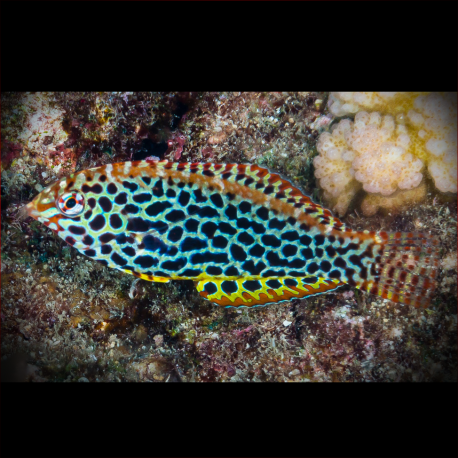More info
Datasheet
| Minimum Tank Size | 500 litres / 132.09 US gallons |
| Maximum Size | 15.0cm / 5.91inches |
| Reef Compatible | Always reef safe |
| Temperament | Docile |
| Temperature | 22.2°C / 71.96°F - 25.6°C / 78.08°F |
| Specific Gravity | 1.020-1.025 |
| Carbonate Hardness | 8-12 |
| pH | 8.1-8.4 |
General Description
The Blackspotted wrasse, also known as Leopard wrasse or Guinea fowl wrasse, belongs to the Labridae family under the Macropharyngodon genus. These wrasses showcase captivating colors and patterns, making them an attractive addition to reef aquariums. They are found in the Indo-Pacific region, ranging from the Cocos-Keeling Islands in the eastern Indian Ocean to the western Pacific and islands of Oceania.
Aquarium Suitability
The Blackspotted wrasse is not recommended for novice aquarists due to its specific demands. They require a well-established aquarium with a deep sandy substrate of at least 5 cm for burrowing behavior. These wrasses feed on small snails and pods, making it crucial for them to find their own food within the tank. Their nutritional needs are essential, and they must not be kept with aggressive tank mates that may deter them from feeding.
Demands, Care, and Hardiness
This species is rated as having average hardiness and a docile temperament. They are sensitive to transportation and acclimatization, often requiring extra care during these processes. Blackspotted wrasses are best kept in a species-only tank or with non-aggressive tank mates to ensure they receive proper nutrition.
Reef Suitability
Blackspotted wrasses are considered reef-safe and can be beneficial in controlling unwanted invertebrates, such as flatworms and pyramid snails, commonly found in reef tanks. Their hermaphroditic nature allows them to change gender from female to male as needed.
Aquarium Setup
For optimal care, a minimum tank size of 500 liters is recommended for housing Blackspotted wrasses. The aquarium should have ample hiding spots and a varied diet consisting of small crustaceans, zooplankton, and frozen foods to supplement their nutrition. Maintaining stable water conditions with a pH of 8.1-8.4, a specific gravity of 1.020-1.025, a temperature range of 22.2-25.6°C, and a carbonate hardness (KH) of 8-12 is crucial for their well-being.
Behaviour
These wrasses exhibit shy and docile behavior, often burrowing into the sand when threatened or in need of rest. They have an excellent biological clock but may take some time to readjust after transportation.
Feeding and Diet
Blackspotted wrasses require frequent feeding, several times a day, especially when newly introduced into an aquarium. Their diet should consist of small crustaceans like krill, mysis, and artemia, as well as zooplankton such as cyclops and pods.
Dimorphism and Captive Reproduction
Blackspotted wrasses can change gender from female to male, with females transitioning when a male presence is required. Captive reproduction of these wrasses can be achieved with proper care and attention to their specific needs.

